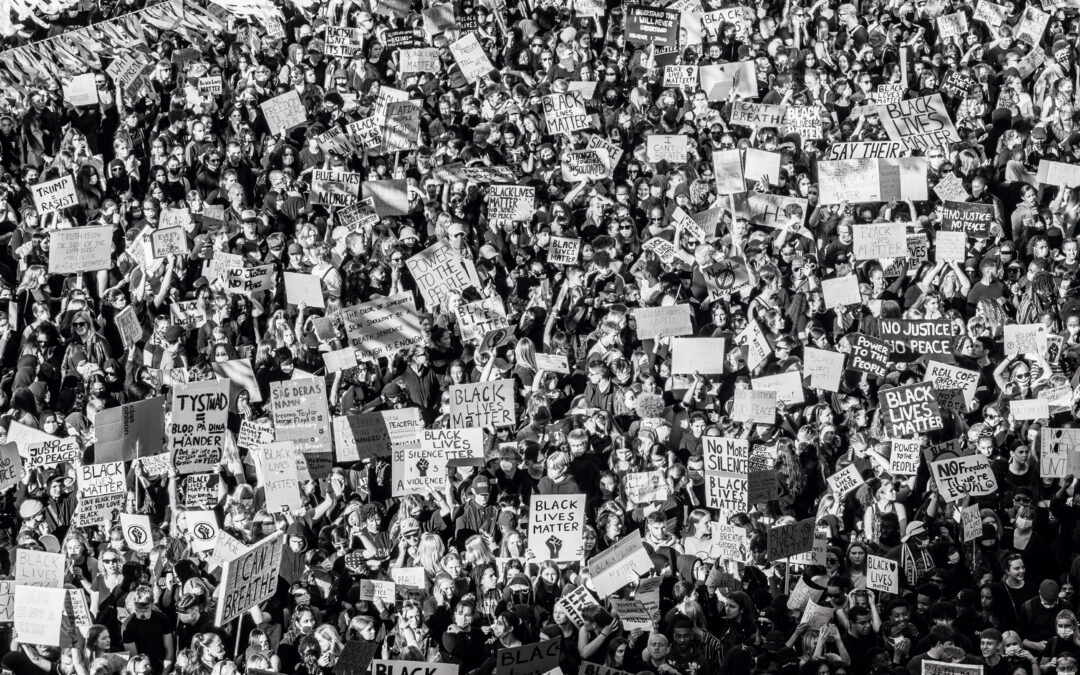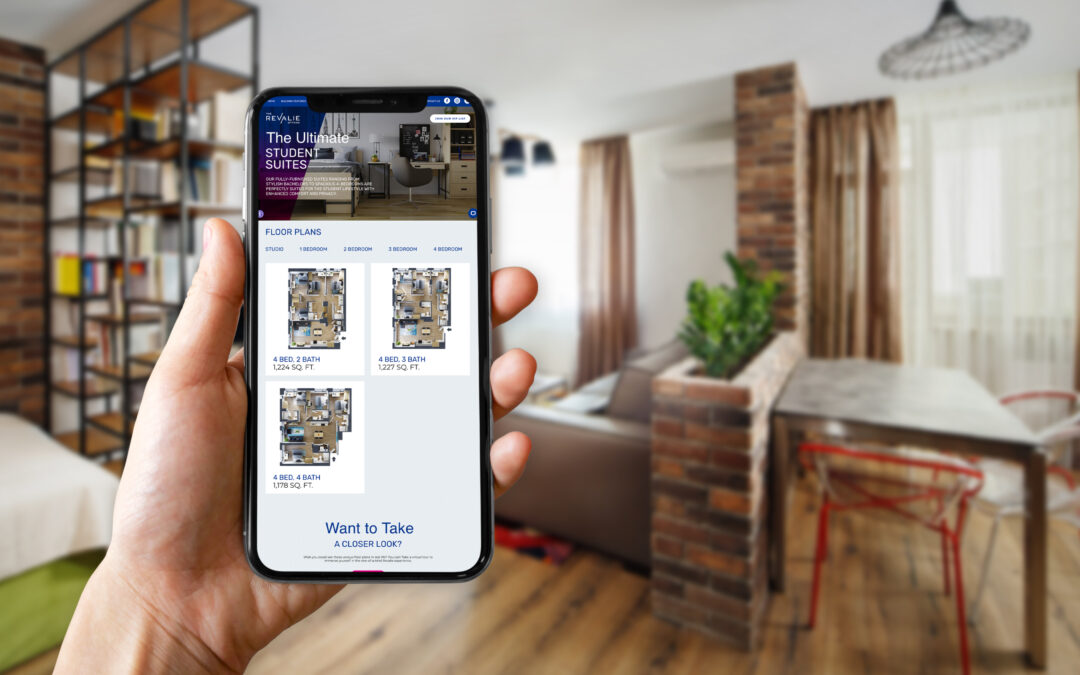
by threshold | Sep 28, 2021 | Creative, Design, General, Marketing, Thought Leadership
 Written by Mike Krankota, Art Director
Written by Mike Krankota, Art Director
There are a lot of elements that go into creating a real estate brand. Everything from voice and tone to visuals like color palettes, shapes, and patterns must be considered in order to develop a coherent brand identity…but in the process of developing a visually striking brand, design efficacy sometimes becomes an afterthought. When this occurs, marketing results suffer, because if your brand doesn’t stand out from the pack, then it doesn’t really matter how pretty it is. In order to stand out, a brand has to not only be eye-catching, but also interesting and memorable against the backdrop of other competitors. As we discuss how to create effective real estate branding, we’ll focus on logo design specifically, but these principles can and should apply to everything from naming to advertising.
Consider brand logos that you’ve encountered and remember. Chances are very likely that it’s not something that looks ‘trendy’ or similar to other brands in its space. The reason it sticks with you? Boldness. For example, consider the candle aisle at your local Target or similar. Can you think of one single brand that has a memorable logo? Not really. They all kind of look the same. It’s either filigree and florals, or stark and modern. “But,” you may be saying, “who cares about the logo, it’s the scent, right?” But when you do see something that stands out for being different, you’re compelled to at least pick that candle up and give it a sniff.

The same applies to your property. Ultimately, a flashy logo design isn’t going to compel potential tenants to live on that property. It’s going to be the interiors, the amenities, the space, the location. So why even care about a big bold brand?
Easy! Because we want to be bold and eye-catching to make that potential renter stop and take a look. We want something that will pique interest and make that person think, “I could see myself living here.” This is doubly true for new construction. When what you have is a construction site and fence wraps, creating an entire vibe with bold branding is extremely important for pre-leasing and lead generation.

Be smart with your logo design as well. The days of just being able to slap some trees flanking “The Oaks at Washington Heights” or whatnot are over. Consumers have become more sophisticated, and demand brands that are tailored to their lifestyle. More to the point: brands that are tailored to their perceived idealized vision of self. It’s always aspirational. This especially plays into the importance of a decision like where a person is going to live. You’re not just selling a place to store your stuff. You’re selling a community. An area. A lifestyle. And overwhelmingly, people want to feel cool and interesting—and to have their home reflect how unique and interesting they feel.
So how do we do that? By embracing the unexpected. Take elements from the location. Consider the design of the property. Analyze the area. Establish the target demographic. And then the key is to execute based on an idealized aspirational vision of that target demographic. For example, a bold brand that targets millennial creatives who want a live/work/play kind of community is very different from a bold brand catering to active adult senior living. But both can be achieved! It all starts by asking the question, “If I were the target resident for this property, what would be a logo that would inspire me to stop and learn more about this cool looking place?”
As you’re considering the answer to this question, don’t fall into the trap of believing everything has to pretty and perfect. Embrace dissonance. Perfectly perfect design is often boring. It’s blandly pretty, with no unique features that create a WOW factor. Imperfections, asymmetricality, bold typographic choices, and even unexpected bursts of color can create a pleasantly dissonant effect that will get your brand described with those words all marketers love to hear: Edgy! Bold! Brash! Unique! Interesting!

Ultimately, the goal is not to blend into the neighborhood. If it was, you could simply put a for rent sign out and not even bother naming the building. Your real goal to stand out. Yes, you want to create something that resonates with the community and the target demographic, but you also want to be a linchpin of that community and not simply a cog. In order to accomplish that goal, it’s important to prioritize bold and impactful design choices over elements that are pretty, but innocuous.

by threshold | Sep 14, 2021 | Creative, Design, Marketing
Apartment branding isn’t what it used to be. In just the last five years alone, the landscape of apartment branding across North America has adapted to dramatic fluctuations in the housing market which have led to new innovations in naming, logo development, and brand identity.
As an apartment marketing agency with expertise in naming and branding projects, we’ve had a front row seat to the shifting needs of renters, owners, developers, and asset managers during this time and enjoyed a position at the cutting edge of the branding innovations that these shifts have inspired.
This experience has not only fascinated us, but also empowered above-market results for our clients, and we hope it will do the same for you. So without further ado, here are the key shifts we’ve seen in apartment branding trends across multifamily, student, and senior living markets within the last five years.
Branding Is No Longer an Afterthought
We couldn’t write about the changes in apartment branding trends without first acknowledging that the attention paid to branding has increased. That is to say, not only have the types of branding choices apartment marketers make shifted over time, but real estate creators and managers are also making these choices earlier and with more care than ever before.
Before the pandemic hit, many rental industries were experiencing a boom of new developments, causing increased competition that required developers, owners, and asset managers to focus their efforts on how they would differentiate their new developments from the competition. This also prompted existing communities to up their game to compete with newcomers, which made rebrands more common than before.
Now, even after the effects of the pandemic, the trend of thoughtful branding has continued because it has become the expectation among consumers and apartment marketers alike.
These days, crafting a brand for a new development typically occurs in tandem with the development and tends to inform and be informed by architectural and interior design processes.
More often than ever before, branding involves a careful research and discovery process, professional assistance from an apartment marketing agency, and the creation of in-depth brand guidelines documents to keep the branding consistent and effective over time and across multiple platforms.

Apartment Names are Bolder & More Memorable
Five years ago, you would find many new developments adopting names incorporating the street number of the complex (e.g. AMLI 5350) or a classic two-word formula featuring words like “Estates,” “Pointe,” and “Vista.” Nowadays, you still see plenty of those formulas being used, but more often, apartment brands are breaking the mold in favor of unique and memorable names that might have felt too bold just a few years ago.
For example, apartment marketers often eschew the familiar in favor of the unique so that brands feel “iconic” instead of “traditional.” Instead of “900 West,” or “Clinton Gardens,” new developments are more likely to be dubbed “NTX,” “Lumen,” or “Mosaic.” Also increasingly common are anthropomorphic names that instantly inject a sense of personality into a community, like “Emara,” or “The Guthrie.”
This trend is particularly true in student housing, where it’s generally understood that Gen Z prospects will overlook the boring and traditional. However, student housing does not have a monopoly on this trend. Even senior living brands are becoming more bold and adventurous, especially as we see a surge in Active Adult communities that emphasize an active lifestyle and resist the narrative of “slowing down” in their retirement-aged residents.
Sustainability & Social Responsibility Have Taken Center Stage
Climate change, racial justice, and public health have all taken center stage in the public zeitgeist, causing renters to pay increased attention to how their housing choices play a role in these factors. Especially among Gen Z and Millennial renters, green living, inclusive marketing, and public responsibility have become important factors in determining whether a brand resonates with them enough to make it into the consideration phase of their renter journey.

Apartment communities new and old have responded to these priorities by incorporating names, taglines, colors, textures and patterns, and brand voices that underscore themes of responsibility, cleanliness, sustainability, and inclusion. For example, brands looking to resonate with eco-conscious renters are adopting greens and blues in the brand colors or incorporating organic elements like plants and animals into their logos.
Student Housing Brands are Ruled By Gen Z Sensibilities
With the oldest Gen Zers now twenty-four years old, student housing has spent the last five years adjusting to the priorities of this generation of renters. That means student housing brands are emphasizing technology, social media presence, sustainability, and affordability more than they were when Millennials were their target audience.
How To Get More Leads & Leases from Gen Z Renters
For example, today’s student housing brands are incorporating messaging that emphasizes “an option for everyone” rather than “exclusive amenities” or “upscale living.” Of course, luxury student apartments are still being built, but even these communities are often leveraging themes of inclusion and attainability in their brand messaging and imagery in order to avoid the impression that they are catering to the wealthy few rather than to the millions of Gen Z renters who came of age during an economic recession and enjoy less public funding for their tuition than any generation before them.
Multifamily Housing Brands are Ruled By Millennial Sensibilities
While the oldest Zoomers are becoming renters in multifamily communities, the largest group of multifamily renters is still the Millennials. Many of these 20 and 30-somethings are experiencing fledgling careers (often changing jobs every two years or so), new parenthood, and mountains of student loan debt, which is making affordable housing, spacious apartments, family-friendly amenities, and work-from-home opportunities more attractive than ever.
Multifamily communities are responding to these needs by emphasizing how their apartments support residents’ careers, families, and physical health while providing an excellent overall value. As with student housing, luxury multifamily housing is still being developed, but the sense of luxury is often communicated through the highlighting of work-from-home conveniences, more spacious interiors, state-of-the-art fitness facilities, and convenient lifestyle perks like housekeeping services, pet grooming, and other factors that make adult life a little bit easier.
Senior Living Brands are Adjusting To The Active Adult Housing Boom
Senior living was once considered only in terms of Independent Living, Assisted Living, and Memory Care facilities, but that’s no longer true. These days, new senior living developments are more likely to be Active Adult communities than the “retirement homes” of yesteryear. This new trend appeals to Boomers and older Gen Xers who are ready to downsize after becoming empty nesters or reaching retirement age, but who are not interested in “slowing down.”
How Senior Living Is Changing
These generations of seniors are redefining what it means to be “old,” and showing apartment marketers how much seniors have been subject to limiting stereotypes and lackluster housing options in the past. It’s no wonder that the Active Adult sector has seen such a boom within the last decade, prompting the senior living industry as a whole to incorporate themes of adventure, discovery, activity, and connectedness in their branding.

by threshold | Aug 24, 2021 | Design, Digital Marketing, Marketing, Tech/Web
Digital apartment marketing experts will often say that it’s important to update your website frequently, but have you ever wondered why? We are often recommending periodic website updates to our clients, but not always for the same reason. The truth is, there are many different reasons why updating your website frequently pays off for your digital apartment marketing goals. Here’s how updating your website can boost your SEO, improve your user experience (UX), increase your online conversions, and more.
Google Will Reward You With Higher Search Rankings
Google takes a lot into account when determining where your site ranks in search results and how current your site is plays a key role in their search algorithm. Think about it: Google wants to deliver users relevant and accurate info when they search so that they keep using Google. Having updated your site recently signals that your website more likely to be up-to-date with accurate info, modern web design, and other factors that contribute to a positive user experience.
Web Standards Are Constantly Changing
If your website hasn’t been updated in several years, there’s a good chance some of the web standards you’re following have gone defunct, fallen out of vogue, or even become illegal. For example, Flash used to be the main way to display multimedia content, but now fewer operating systems are supporting it because there are better ways to accomplish what Flash was once used for. Web security guidelines and requirements are also constantly being updated.
Additionally, state, federal, and international regulations can also dictate what you must and must not have on your website. For example, nearly every website now has a pop-up of some kind prompting users to accept the use of cookies in order to use their site.
Helps You Keep Up With Apartment Marketing Trends
You may be keeping up to date with apartment marketing trends in your industry, but does your website reflect that? Planning regular website updates puts you on a schedule to audit your website for off-trend features, messaging, and design elements that can make your community seem older and less desirable. For example, it may be time to update your amenities list to reflect how people are referring to their amenities these days (e.g. dog park vs. bark park, sparkling pool vs. resort-style pool, etc.). Additionally, take a look at the functionality your competitors are including on their site: Do they have a chatbot? An online tour scheduler? Virtual tours for every floor plan? Are you less competitive in your market if you don’t have these features?

On a related note, take a look at the information your competitors are including on their websites. The recent example of COVID-19 messaging, which is now common on apartment websites, shows how important it can be to make timely website updates in order to meet the new expectations of your audience and keep up with your competitors.
Leads to More Conversions
Keeping up with or even pushing ahead of the curve goes a long way to inspiring confidence from prospects and current residents alike. Your site doesn’t have to be flashy and cutting edge, necessarily, but just having accurate information, timely specials, no broken links, and messaging that speaks to trending housing needs can ensure your property makes it from a prospect’s awareness phase to their consideration phase. Plus, residents who see their apartment community working hard to maintain consistent website functionality and provide current information will be that much more likely to renew their lease and recommend your property to others.
Best Ways to Update Your Real Estate Website Regularly
So now that we’ve established why you would want to update your website regularly, what are the best ways to go about that? It all depends on what your primary goals are and what resources you have at your disposal.
Adding a blog to your website is one of the most common ways to incorporate regular website updates into your digital marketing strategy. This isn’t just so that you can share useful information with residents and prospects, it’s also a great way to boost your on-page SEO efforts. Not only does it allow you to update your site each time you post (signaling to Google that your site is current), but it also gives you added opportunities to incorporate SEO keywords without running the risk that Google interprets your efforts as keyword stuffing because your keyword density is too high on a given page (which can actually hurt your SEO).

But while a blog is great for SEO, it isn’t the only way to update your website regularly. Consider: what do your prospects need from your website? Were there features you didn’t initially include that you could add now, like a chat bot, tour scheduler, or virtual tours? Do you have current photos or video of all your amenities and community spaces? Do your prospects have a way to view current specials? Could you benefit from adding resident reviews on your website?
In addition to these considerations, we recommend that once a year or so, you review your keyword strategy. If you’re not sure how to create a keyword strategy, check out our post on How To Do Keyword Research For Your Real Estate Website. As search trends change, you may find that you’re missing out on a lot of potential traffic from keywords you hadn’t been targeting before.
Finally, every few years, we recommend that you do a more in-depth design update. Trends change and a website can begin to look out-of-date quickly. You don’t necessarily have to overhaul your entire website design, but a few tweaks here and there can help you keep up with the times.

by threshold | Aug 11, 2021 | Creative, Design, General, Marketing, Thought Leadership
 Written by Emily Barker, Graphic Designer
Written by Emily Barker, Graphic Designer
In the midst of the murder of George Floyd and the ensuing protests around the U.S., the design community revived discussions of anti-racism and activism and how it fits into the field of Graphic Design. Just what exactly does designing for social change look like? Specifically in the field of marketing and advertising, the topic of social justice can often feel at odds with the day-to-day worklife in an agency. That’s especially true in the field of real estate–centered design, where the emphasis is often ‘heads-in-beds’ and being 100% leased up, without much room for discussions on equity. However, this sort of all-or-nothing thinking, especially in fields that are complicated, nuanced, and related to issues of housing and equity, can stymie conversations on race and equity before they even get started. The truth is that there are many avenues toward anti-racist marketing while also meeting the needs of clients whose focus is on leads and leases, and real estate designers have a unique position in advocating for those anti-racist strategies.
Creating Historically-Informed Real Estate Design
Anoushka Khandwala in her article entitled “What Does it Mean To Decolonize Design” talks about understanding the schema of one’s own history as a way to re-examine motivations and find new and better modalities of design for the future. She argues that, “With every design choice we make, there’s the potential to not just exclude but to oppress; every design subtly persuades its audience one way or another and every design vocabulary has history and context.”
What can that mean for us as real estate designers? At Threshold we delved into the history of redlining and the Fair Housing Act as a way to better understand the industry and its numerous failures and shortcomings. This meant a combined team of creative and digital staff researched the history of the Fair Housing Act and redlining to create an agency-wide presentation of the history of the Fair Housing Act and red-lining. The creative team made social posts outlining the history of redlining and the creation of the Fair Housing Act during the 1960’s Civil Rights Movement. For more information on redlining and how it denied Black American’s housing and generational wealth in the U.S. please click here.

What this revealed to us was that, as real estate marketers, we had an obligation to help our clients adhere to the FHA rules and regulations. Strictly speaking this meant using photos of diverse individuals in the marketing materials, ensuring that websites were ADA compliant, and using FHA and ADA icons. But it also revealed holes in the system or gray areas where we could advocate for our clients to choose inclusive marketing and branding strategies and also choose to go above and beyond in their digital marketing strategies to prioritize inclusivity.
How Designers Can Be Advocates for Social Change
In Jarrett Fuller’s article on Isometric Studios he describes the studio as one that is “rethinking the way in which designers build a better world”. The founders Andy Chen and Waqas Jawaid describe their clientele as broad: “We’ll take on any kind of client who demonstrates a desire to think about what authentic inclusion looks like, what foregrounding marginalized narratives looks like.” The article goes on to describe the work of Isometric as that of advocates as well as designers.
This is a familiar role for designers as we are already advocating for good design as we talk to our clients about our work and advise them on the best choices for their brand. Isometric Studios would take that same advocacy a step further and challenge the client’s perspective on social issues when needed and advocate for development of brands that support the greater social good. Sometimes this advocacy can look like recommending that a client incorporate people of diverse races in their lifestyle photography or choosing a logo that celebrates the existing community culture where their new development will be built.

One important way to have these conversations with clients is to directly addressing the elephant that is so often in the room: gentrification. By addressing this openly we are better able to advocate for our clients to help them maintain a positive reputation and resident satisfaction. These types of conversations present the opportunity for us to simultaneously advocate for our client and the greater community’s needs by encouraging our clients to create positive connections with their communities.
How do we ask our clients to connect with the communities they will exist in? Here are a few suggestions:
- Hosting events for the neighborhood at the property
- Striking mutually advantageous partnerships with local businesses
- Resident appreciation events that feature goods and services from the local community
- Hiring local instructors to teach fitness, art, or meditation classes
- Hiring local artists to design artwork for the property
- Host a concert of local musicians
- Offer communal spaces to local groups for weekly meetings
- Organize volunteer days with residents or staff in the local community
The point of these conversations and ongoing partnerships with the community isn’t to whitewash the real estate industry, but to offer real-world pathways for community engagement for our clients.
Isometric Studios, in their interview with Jarrett Fuller describes their name’s origin as “a floor plan drawn at a thirty degree angle where the same scale is used for every axis, creating a non-distorted image. ‘It’s an ideal that isn’t really possible,’ Jawaid said. ‘But we’re interested in that ideal. We’re designing for that ideal.'”
In the same way, we can also struggle towards a more ideal design practice in real estate design. We can become advocates for creative work that will be better suited for this current, complex, and multicultural world and our clients will benefit from the nuance that design will bring to their brands.

by threshold | Jul 6, 2021 | Creative, Design, Digital Marketing, General, Marketing, Tech/Web
Floor plans: every apartment marketing team needs them, but how important are they really? You might be surprised at how big a role floor plan graphics have to play in your digital real estate marketing strategy. Not only can a lack of floor plan graphics result in poor UX on your website, but it can also rob you of key branding and marketing opportunities that help drive qualified leads and conversions.
Here are some of the key ways floor plan images can make or break your digital real estate marketing results.
Prospects Refine Their Apartment Search Based on Floor Plans
Keyword research shows that, no matter what your market or your target audience is, people are searching specifically for floor plans based on the number of bedrooms. It’s part of what makes ILS platforms like Zillow and ApartmentFinder so popular; users can refine their search by the number of bedrooms and bathrooms. But when they take their search to Google, they refine their search manually by typing in search terms like “3-bedroom apartments in Austin” or “studio apartments Austin.”

These search habits have a lot to teach us about user intent: from the very beginning of their apartment search, the number of bedrooms is central to their housing decision. When a prospect encounters difficulty in gathering detailed floor plan information about your property, they’re that much more likely to bounce from your website or disqualify your property as they move into the consideration phase of the digital renter’s journey.
And the more information prospects can learn from these floor plans, the more likely they are to recognize your property as a viable option and take the next step by scheduling a tour or starting an application. In other words, 3-D floor plans, floor plans with dimensions, and higher-resolution floor plan graphics help result in more qualified leads coming in through your web presence.
Floor Plan Images Can Be Used Throughout Your Digital Real Estate Marketing
Floor plans aren’t just for your brochure or your website (although you should definitely use them there!). Floor plan images also provide fodder for additional digital marketing platforms like Google My Business posts, social media posts, and ad images or video. And the higher quality these floor plans are, the more versatile they will be.
Say, for example, that one of your floor plans has a high vacancy rate while others are sold out. Having high quality floor plan images means you can easily promote that specific floor plan through your posts and stories on Instagram and Facebook. You could also run an ad campaign featuring the floor plan graphic alongside interior photos or renderings. Carousel ads and video ads work particularly well for this purpose.
Floor Plans and Site Plans Add Branding Opportunities
Floor plans aren’t just a convenient way to convey information. They’re also an opportunity to show users that you’re committed to providing a positive user experience, which also signals that they can expect a positive renter experience at your community. Plus, floor plans and site plans can be used in creative ways to highlight your brand personality. Doing so ensures that your units don’t blend in among all your competitors offering similar unit types.

Everything from brand colors and patterns to unique messaging can be added to your floor plan design. You could show off your branding through the floor plan design itself or by adding a branded border or background. You could even implement a unique hover state on each floor plan image on your website, if you have the ability to do so. Whatever tactic you choose, the more you can signal that your apartments are unique to your community, the more likely it is that your prospects will pay attention and eventually reach out to schedule a tour or start an application.
High-Quality Floor Plans Signal Modernity and Reliability
Not all floor plan graphics are created equal. A low-quality, low-detail floor plan image can be almost as bad as no floor plan at all. Your floor plan images should be accurate to scale, have good color contrast (which is particularly essential for prospects with color blindness or other vision impairments), and match the look-and-feel of your brand. If they feature easy-to-read dimensions, room labels, and amenity labels for sought-out features like in-unit washer and dryer and walk-in closets, that’s even better. Best of all, 3-D floor plans help bring your apartments to life complete with interior design elements and a clearer sense of scale for the viewer.

For the sake of argument, let’s compare the two floor plan images above. While the 3-D floor plan on the right does not include labels or dimensions, it still does a much better job of portraying the scale, features, and personality of the one-bedroom apartment it represents. A user viewing this floor plan can imagine themselves living there and feels confident that the unit comes with the amenities that are important to them, since they are clearly visible in the image. Meanwhile, floor plans like the one of the left don’t inspire much confidence in the user viewing them. Why? Not only does it lack detailed labels or dimensions, it also makes it challenging for the viewer to understand how large each room will feel, how modern the unit is, and what amenities it has. The apartment on the left could be fantastic, but it comes across as lackluster and illegible, making it less likely that a user will continue exploring this community for long enough to fall in love.
Those are just some of the key ways that floor plan graphics can make or break your digital real estate marketing results. For more information on how you can improve your digital marketing results, check out our post on How To Improve UX on Your Property Website (and increase conversions) or take a scroll through the Digital Buyer’s Journey For Real Estate.

by threshold | Jun 1, 2021 | Creative, Design, Marketing, Tech/Web, Thought Leadership
 Written by Chelsea Friel, Graphic Designer
Written by Chelsea Friel, Graphic Designer
Designing with accessibility at the forefront has never been more important, but it can be daunting to determine whether or not your website is in compliance with regulations. In 2020 alone, over 3500 digital accessibility lawsuits were filed, including federal and state ADA lawsuits, and an estimated 56 million people in the U.S. are currently living with a disability. As we look to expand our services in the real estate and housing market, it’s paramount that we keep accessibility top of mind in our work. The goal is to improve our practices to make our designs as accessible as possible for the widest audience, and to make usability as high a priority as visual appeal.
What Does Web Accessibility Look Like?
To be frank, the word “compliance” doesn’t exactly bring to mind a font of creative flights of fancy. It usually summons images of black Arial text neatly organized on a white background, which is fine for doing your taxes but less than ideal for promoting your sparkling new multifamily property. In truth, adhering to Web Content Accessibility Guidelines (WCAG, from here on out) is pretty easy to incorporate alongside our existing design practices. WCAG ratings are ranked from A to AAA, in a sort of “good, better, best” system. If A is the rank for a solidly usable website, then AAA is the gold standard of accessibility.
Similarly to how we build successful brands that thrive in the wild, the process of establishing an accessible web presence requires some collaboration between designers, copywriters, and developers. By keeping a few helpful guidelines in mind, each team’s work contributes to a fully accessible real estate website that anyone can (and will want to) use, regardless of their level of ability.
A Helpful Guide for Accessible Design
Contrast
When establishing a color palette, high contrast is critical for usability. When considering moderate to severe visual impairment, the ideal contrast ratio is between 1 to 3 and 1 to 4.5, depending on the size and the boldness of the text. The larger and thicker the characters, the lower the ratio can be while maintaining legibility to the eye, or to a screen reader. Any important copy should be designed with the highest contrast possible to ensure greater visibility for users.

Chrome extensions such as Spectrum can help you determine how user-friendly your website is by showing you alternate versions of your website based on various visual abilities.
Alternate Indicators
On the topic of visual acuity, consider using alternate methods of establishing a hierarchy of content apart from color changes. If a piece of text changes color when a user hovers, the addition of a line under the text serves as an additional cue that the copy can be clicked or is interactive in some way. Other visual indicators can be icons, boxes, or typeface changes (such as semibold to bold or black) to indicate to the user that they’re on the right track.

Charts and graphs can also present a challenge. Apart from using distinct colors to designate a data set, one solution is to incorporate texture or patterns into the design to further differentiate the information presented to the user. Trello has a plugin that can convert graphs using color blindness–friendly patterns to help aid legibility for all users, while maintaining the overall look and feel of the design.
Alt Text & ARIA Labels
Used to describe an image when it is unavailable to the user, alt text and ARIA labels should provide as much detail as possible. Describe what’s happening in the image instead of opting for the file name or a bland categorization of the subject like “man” or “house.” For folks who use screen readers to navigate websites, this attention to image descriptions provides a much clearer idea of what is in the design and what the website is trying to convey. This can be a key factor in whether or not they pursue your property further, depending on how well you describe the photo of the premises or the neighborhood using these tags and labels.

Content and Type Hierarchy
When writing copy for a website, simpler is better. Important messages should be short and to the point, while conveying all of the essential information a user needs to know right off the bat. WCAG recommends limiting a line of text to 80 characters or fewer, and to avoid writing overly complicated or lengthy sentences. Designers and copywriters should work in tandem to draft copy that looks beautiful in the design, excites the user with its content, and can be read by as many people as possible, regardless of the tools they use to view the website.
UI and Navigation
Users of varying abilities frequently use keyboard navigation to explore websites, and care should be taken to establish a logical flow of information. Good design is obvious, and a user shouldn’t have to spend time deciphering how to move through a website to find what they need. Clean focus states, clear and easy-to-remedy error states, and concise links makes a site more accessible to all, and provides a better user experience across the board.
Designing for Everyone
Accessibility should always be as high a priority as creating a beautiful design. A visually stunning website that can only be accessed by half of our users is ultimately a design failure, and our goal should be to be as inclusive as possible in our work. As we continue to go above and beyond for our clients and our audience, normalizing accessibility practices deepens our understanding of who we serve, and provides a more inclusive space where all are welcome.

 Written by Mike Krankota, Art Director
Written by Mike Krankota, Art Director










 Written by Emily Barker, Graphic Designer
Written by Emily Barker, Graphic Designer






 Written by Chelsea Friel, Graphic Designer
Written by Chelsea Friel, Graphic Designer

